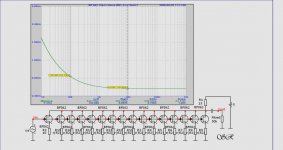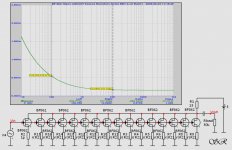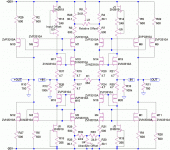I've recently seen a paper of a guy who read out SQUIDs with a single Infineon SiGe BFP650 at cryo temp.
Did this with Si JFET @ 10-12K 15 years ago. Good old days...
Yeah, sorry, I mixed this up with the notion that Siemens apparantly never made a EL34, that was my point. Other tubes than EL34's they used to make of course, in their own fab (I have a bunch of E83CC's in a drawer).gerhard said:Since you are in Berlin, you really should know better:
http://www.siemens-stadt.de/siemroe0.htm
3 years ago, I still saw guideposts there in Siemensstadt.
I think they still make microwave TWTs
BTW, @John, did you receive my PM?
- Klaus
Terry Demol said:Speaking of interfet, don't they do sk170 / sj74 replacements?
No, that's Linear Systems. But they only have the 170 replacement. They've been promising the 74 for at least a couple of years now but so far haven't delivered.
se
>I have used IRF610 and 9610 types
>as input devices for power amps and
>as the only devices in some line stage
>circuits, and while nobody complained,
>they clearly are way noisy compared to
>good JFETs or Bipolars.
OK ..... Would you please compare IRF610
to it's higher power equivalent ... I.E.
Mosfet with same breakdown voltage,
threshold voltage, more gm and higher
power rating (current capability) , noisewise ?
Just to make a perhaps an impracticle point ?
Dare to be even greater !
>as input devices for power amps and
>as the only devices in some line stage
>circuits, and while nobody complained,
>they clearly are way noisy compared to
>good JFETs or Bipolars.
OK ..... Would you please compare IRF610
to it's higher power equivalent ... I.E.
Mosfet with same breakdown voltage,
threshold voltage, more gm and higher
power rating (current capability) , noisewise ?
Just to make a perhaps an impracticle point ?
Dare to be even greater !
PMA -
my experience is that a small RC-filter on the input with superb passive components does not affect sonics. With small I mean 50-100 Ohms and 10-100pF, and with superb passives I mean film&foil type PS and or PP caps.
Sigurd
my experience is that a small RC-filter on the input with superb passive components does not affect sonics. With small I mean 50-100 Ohms and 10-100pF, and with superb passives I mean film&foil type PS and or PP caps.
Sigurd
PMA said:I mean the capacitor influence on sound, and possible benefit of RF reduction vs. capacitor problem - I asked for no trivial answers, Upupa.
P.S.: Any lower rate college student could answer me about phase response, it is not helpful. I am asking for experience in this field.
Of course not,
PS = PolyStyrene
I do not even use polyester for decoupling in my audio amps (or in loudspeaker cross overs)....been there, done that.
Sigurd
PS = PolyStyrene
I do not even use polyester for decoupling in my audio amps (or in loudspeaker cross overs)....been there, done that.
Sigurd
PMA said:Sigurd,
I hope you do not mean polyester (mylar), when you write PS.
0.2 nV / sqrt (Hz)
Designing amps with less than 0.4 nV/sqrt(Hz) eq. short-circuit input noise is nothing I have done in real life,
but I thought I'd do it in SPICE to see what it would take.
Here's a design with 15dB gain and 250MHz BW using 16 pcs BF862 JFETs in parallel each having a 10 Ohm sorce resistor..
Vout_DC is at mid-rail.
en is 0.21 nV/sqrt(Hz) at 10kHz and rises to 1.6 nV/sqrt(Hz) at 10 Hz.
At 1k, 10k, 100kHz and 100 mVrms output, THD is 0,4% (2nd only).
Regards,
Sigurd
Designing amps with less than 0.4 nV/sqrt(Hz) eq. short-circuit input noise is nothing I have done in real life,
but I thought I'd do it in SPICE to see what it would take.
Here's a design with 15dB gain and 250MHz BW using 16 pcs BF862 JFETs in parallel each having a 10 Ohm sorce resistor..
Vout_DC is at mid-rail.
en is 0.21 nV/sqrt(Hz) at 10kHz and rises to 1.6 nV/sqrt(Hz) at 10 Hz.
At 1k, 10k, 100kHz and 100 mVrms output, THD is 0,4% (2nd only).
Regards,
Sigurd
Attachments
Depends on what you're calling profound new.scott wurcer said:It's pretty clear the Blowtorch is not going to yield any profound new circuit topologies so I'll try elsewhere.
This one is all Mosfet, no unobtanium J-Fets, no BJT's, no global feedback, no tubes, no transformers.
The input offset currents may give a headache though...

Tino
Attachments
Thanks PMA, for your input.
I might summarize about noise, and its design history:
The first real breakthrough for me was a paper in 'Electronics Letters' in 1966, by an Englishman. It clearly pointed out that you could parallel transistors or fets and get just about any noise voltage that you wanted. The circuit described looked like the one put here last night by Sigurd.
In 1967, I visited Ortofon in Copenhagen to get info on their built in phono transformer that was connected to their MC cartridge. I mentioned to them that I wanted to build a substitute for the transformer with new technology. They told me at the time that it was impossible, their best engineers had looked into it, and then they showed me the door.
When I got a job at Ampex a few months later, my new boss 'stuck me' with the boring task of measuring transistors with a Quantech noise analyzer. I found it fun to measure transistors, so I measured samples on Ampex's entire inventory. Then, then I asked for samples from outside manufacturers like Motorola. They sent me the first samples of the 2N4401, 4403, and 2N4405. Eureka! I hit the jackpot. These new devices, and paralleling gave me complete dominion over noise! I wrote it up in a paper for the Ampex audio department and left to join the research division. So, by 1968, I knew pretty much everything that has been said here on noise, so far. (can anyone now understand why I sometimes lose patience?)
Still, low noise numbers are not everything. What about distortion, input and output coupling caps? Can't we get rid of these also? It took me years, before I came up with the circuit that is patented in my name, and I am justly proud of it, even though it is now not very practical, compared to other design approaches. We introduced the JC-1 pre-preamp at the NY AES in the fall of 1973 It did set the world on fire with a great review in 'The Absolute Sound' and of course, people were telling me that my noise numbers (0.4nV/rt. Hz) were impossible to achieve without a transformer.
I still was unhappy with the design, not because of noise, but distortion. I wanted lower distortion, so I switched to complementary Toshiba Jfets in 1981 or so, and Vendetta was born. It measured about 100 times lower distortion, open loop, than my previous design. I still use the same basic input stage, and will in future. However, I will not give this design away to anyone, as I still make a living from my designs, so please quit asking.
I might summarize about noise, and its design history:
The first real breakthrough for me was a paper in 'Electronics Letters' in 1966, by an Englishman. It clearly pointed out that you could parallel transistors or fets and get just about any noise voltage that you wanted. The circuit described looked like the one put here last night by Sigurd.
In 1967, I visited Ortofon in Copenhagen to get info on their built in phono transformer that was connected to their MC cartridge. I mentioned to them that I wanted to build a substitute for the transformer with new technology. They told me at the time that it was impossible, their best engineers had looked into it, and then they showed me the door.
When I got a job at Ampex a few months later, my new boss 'stuck me' with the boring task of measuring transistors with a Quantech noise analyzer. I found it fun to measure transistors, so I measured samples on Ampex's entire inventory. Then, then I asked for samples from outside manufacturers like Motorola. They sent me the first samples of the 2N4401, 4403, and 2N4405. Eureka! I hit the jackpot. These new devices, and paralleling gave me complete dominion over noise! I wrote it up in a paper for the Ampex audio department and left to join the research division. So, by 1968, I knew pretty much everything that has been said here on noise, so far. (can anyone now understand why I sometimes lose patience?)
Still, low noise numbers are not everything. What about distortion, input and output coupling caps? Can't we get rid of these also? It took me years, before I came up with the circuit that is patented in my name, and I am justly proud of it, even though it is now not very practical, compared to other design approaches. We introduced the JC-1 pre-preamp at the NY AES in the fall of 1973 It did set the world on fire with a great review in 'The Absolute Sound' and of course, people were telling me that my noise numbers (0.4nV/rt. Hz) were impossible to achieve without a transformer.
I still was unhappy with the design, not because of noise, but distortion. I wanted lower distortion, so I switched to complementary Toshiba Jfets in 1981 or so, and Vendetta was born. It measured about 100 times lower distortion, open loop, than my previous design. I still use the same basic input stage, and will in future. However, I will not give this design away to anyone, as I still make a living from my designs, so please quit asking.

- Status
- Not open for further replies.
- Home
- Amplifiers
- Solid State
- John Curl's Blowtorch preamplifier



